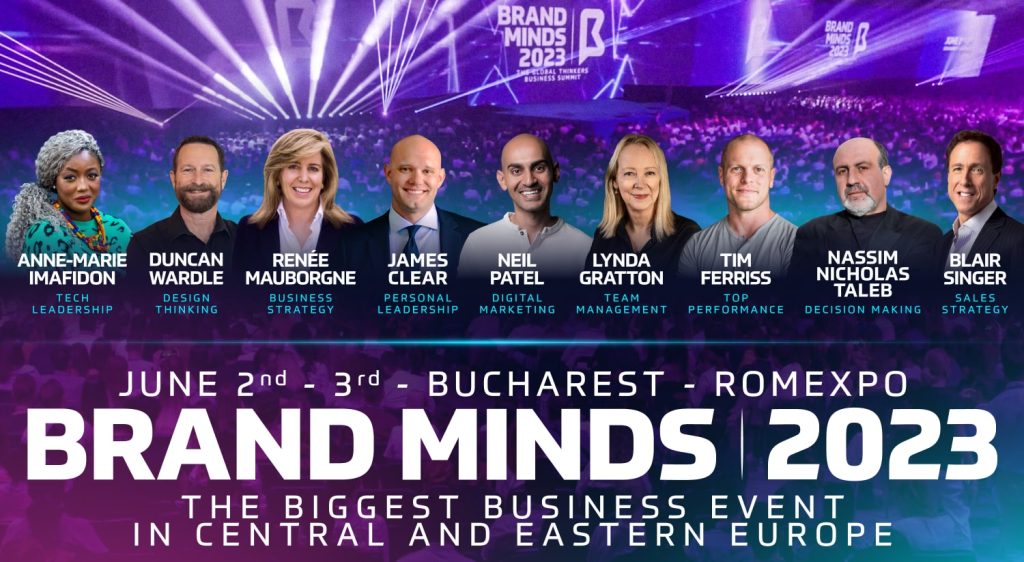Top 7 biggest tech acquisitions of 2020
(UPDATED) What are the top 7 biggest tech acquisitions of 2020?
1. Oracle to take a 12.5% stake in TikTok Global
TikTok became available in the American market in 2018 after merging with another social media service Musical.ly.
Within two years, TikTok US has increased its monthly user base to 100 million, up 800%.
According to SensorTower, TikTok was the most downloaded app in 2020 with 82 million downloads globally.
Was TikTok’s global surge in downloads a result of Donald Trump’s threat to ban the US operation of the Chinese social app? Most likely.
Was the pandemic lockdown a contributing factor? Definitely yes.
In September 2020, Oracle announced that it was chosen to become TikTok’s secure cloud technology provider.
The company’s press release also reports that the decision was heavily influenced by Zoom moving a large portion of its video conferencing capacity to the Oracle Public Cloud.
According to Oracle Chief Technology Officer Larry Ellison, the cloud infrastructure is “much faster, more reliable, and more secure than the first generation technology currently offered by all the other major cloud providers”.
As part of the agreement, Oracle will become a minority investor in TikTok Global with a 12.5% stake in the company. How much is that worth? Well, it was estimated that ByteDance, TikTok’s parent company is valued at $100 billion and that TikTok’s US operations account for about 40% of ByteDance’s valuation, or about $40 billion. This means that Oracle’s stake is worth $5 billion.
However, the agreement is yet to be finalized with the American government granting TikTok an extension of its forced sale deadline until December 4, 2020.
2. Salesforce to acquire Slack for $27.7 billion
Salesforce is the top CRM providers worldwide empowering companies of every size and industry to digitally transform and create a 360° view of their customers. It is one of the fastest-growing enterprise software companies of all time with over 150,000 customers ranging from small businesses to FORTUNE 500 companies.
In 2019, Salesforce increased its market share to 18% followed at a distance by its competitors SAP, Oracle, Microsoft and Adobe.
In December 2020, Salesforce announced that the CRM provider has entered into a definitive agreement with Slack under which it will acquire the latter for $27.7 billion. Slack is one of the most innovative enterprise communications platforms. You can learn more about its growth story here.
This is a match made in heaven. Together, Salesforce and Slack will shape the future of enterprise software and transform the way everyone works in the all-digital, work-from-anywhere world. I’m thrilled to welcome Slack to the Salesforce Ohana once the transaction closes.
Marc Benioff, Salesforce CEO
3. Microsoft to acquire games developer ZeniMax Media for $7.5 billion in cash
Two years ago, Microsoft acquired seven games developer studios.
Today the market has grown to 3 billion gamers from 1 billion in 2018 and is expected to bring more than $200 billion in annual revenue in 2021. The gaming industry is one of the fastest-growing industries worldwide registering a CAGR of 9.17% over the forecast period (2020 – 2025).
With the acquisition of ZeniMax Media, the parent company of Bethesda Softworks, one of the largest, privately-held game developers and publishers in the world, Microsoft consolidates its foothold in the gaming industry. Under the terms of the agreement, Microsoft will acquire ZeniMax Media for $7.5 billion in cash.
ZeniMax Media are the creators of critically acclaimed and best-selling gaming franchises including The Elder Scrolls and Fallout among many others.
With unique investments in content, community, and the cloud, Microsoft’s gaming strategy differs from others by empowering people to play the games they want, with the people they want, anywhere they want. Games are the primary growth engine in gaming, and games are fueling new cloud-gaming services like Xbox Game Pass, which has reached a new milestone of over 15 million subscribers. With the addition of Bethesda, Microsoft will grow from 15 to 23 creative studio teams and will be adding Bethesda’s iconic franchises to Xbox Game Pass.
Microsoft Press Release
4. Adobe acquires work management platform for marketers Workfront for $1.5 billion
In November 2020, Adobe announced it has entered into a definitive agreement to bring Workfront, the leading work management platform for marketers, to Adobe Experience Cloud for $1.5 billion.
Founded thirty-eight years ago, Adobe continues to deliver award-winning software and technologies that have redefined and advanced business and personal communications.
Adobe Illustrator® and Adobe Photoshop® are groundbreaking software used by more than 90% of creative professionals worldwide for digital image editing and creation.
Adobe Experience Cloud is the most comprehensive solution for content and commerce, customer journey management, and customer data and insights, all built on an open platform, enabling businesses of every size across every industry to deliver exceptional customer experiences at scale.
With the acquisition of Workfront, Adobe makes the digital transformation easier for its customers.
Workfront has more than 3,000 customers and 1 million users and deep leadership in orchestrating marketing workflows. Workfront’s platform is agile and uniquely architected for the enterprise, with extensive integration capabilities that can be easily configured to meet the varied needs of companies of all sizes.
Together, Adobe and Workfront will provide our customers access to a single system to support planning, collaboration and governance that will unlock organizational productivity. Now marketers will not only create and deliver the best customer experiences but also efficiently and seamlessly manage the workflows that bring these experiences to life.
Adobe press release
5. Amazon to acquire self-driving tech startup Zoox for an estimated $1.2 billion
With a market capitalization of $1.7 trillion, Amazon is the third most valuable tech company in the world following Microsoft and Apple.
In June 2020, Amazon has signed an agreement to acquire Zoox, a self-driving tech startup designing autonomous technology from the ground up with passengers front-of-mind.
Amazon’s support will get the startup closer to its mission of delivering safe, clean, and enjoyable transportation to the world. Founded in 2014, Zoox’s tightly integrated features are designed to provide a revolutionary passenger experience. The startup has raised $955 million in venture-backed funding.
Amazon hasn’t disclosed the purchasing value of the agreement but industry experts estimate it is a little over $1.2 billion.
What are Amazon’s plans for Zoox?
Some experts say the company will more likely integrate Zoox’s technology into its distribution network than building a fleet of autonomous driving cars. This might happen in the near future.
For now, Zoox is sticking with its mission and is preparing to unveil its ride-hailing vehicle on December 14 under the tagline The future is for riders, not drivers.
6. Facebook to acquire customer-focused platform Kustomer for a reported $1 billion
In November 2020, Facebook announced that it reached an agreement to acquire Kustomer, a top-rated CRM that enables businesses to effectively manage all customer interactions across channels.
The goal of the platform with over 2.7 billion monthly active users is “to give businesses access to best-in-class tools that deliver excellent service and support.”
Facebook reports that more than 175 million people contact businesses via WhatsApp every day. Kustomer helps businesses optimize their time and quality of interactions with customers by bringing customer conversations from various channels together into a single-screen view.
Facebook plans to support Kustomer’s operations by providing the resources it needs to scale its business, improve and innovate its product offering, and delight its customers. That way, more people will benefit from customer service that is faster, richer and available whenever and however they need it, whether it’s phone, email, web chat or messaging.
Facebook press release
7. Cisco to acquire audience interaction company Slido for an undisclosed amount
In December 2020, Cisco announced its intent to acquire privately-held Slido, a technology company that provides a best-in-class audience interaction platform.
Cisco’s acquisition is a strategical business decision which allows the company to stay competitive with Zoom. Webex, Cisco’s video conferencing solution had 600 million participants in October 2020.
Slido developed a Q&A and polling platform designed to bridge the gap between speakers and their audiences. The company’s platform provides for its 7 million participants monthly a web-based application to actively engage people and get real-time feedback before, during, and after events and meetings.
With Slido’s technology, Cisco will integrate even more insights into the Webex platform to help everyone work smarter and be more productive whenever and wherever work happens. We are going to enable companies around the world that have traditionally relied on in-person events like townhalls, all-hands meetings and major user conferences to make sure everyone is engaged and included.
Cisco press release
How to apply the PESTEL analysis to support your business vision
In this article:
- What is PESTEL business analysis?
- What does PESTEL acronym stand for?
- PESTEL factors explained
- When should you use PESTEL analysis for your business?
What is PESTEL business analysis?
PESTEL business analysis is a framework for helping entrepreneurs and business people to understand the impact of macro-environmental factors on their business.
What does PESTEL acronym stand for?
The PESTEL acronym stands for
![]() Political
Political
 Economical
Economical
 Social
Social
 Technological
Technological
 Environmental
Environmental
 Legal
Legal
The PESTEL analysis was created in 1967 by Harvard Business School professor Francis J. Aguilar.

Francis J. Aguilar
PESTEL/PESTLE/STEEPLE – are they the same thing?
Yes, PESTEL, PESTEL and STEEPLE refer to the same business framework. The only difference is that the letters are switched between them. In the case of STEEPLE, the additional E stands for Ethics.
PESTEL factors explained
PESTEL is the second strategic tool for decision-making we are highlighting on the BRAND MINDS blog.
Our mission is to help you acquire relevant knowledge that will support you to make good business decisions. Learn how to grow your business with PORTER’S 5 Forces framework.
The factors analyzed by the PESTEL framework refer to the macro-environment of your business. Not to be confused with the external factors of your business.
Let’s think of your business as the Earth.
The Earth is made up of four layers: the inner core, the outer core, the mantle and the crust.
The inner core of your business is comprised of your business’s organizational structure, culture, employees, management and operations. They are the internal factors.
The next layer surrounding your business is the outer core: competitors, suppliers, distributors, customers and partners. They are the external factors. These factors and your business are in a two-way relationship – they influence each other. If you want to assess how much power your competitors or your buyers have on your business, apply PORTER’S 5 Forces framework. You will get a map of the industry your business operates in as well as the structural underlining drivers of profitability and competition.
The third layer of your business comes over the external factors and it’s called the macro-environment. The macro-environment includes the factors listed earlier in the article: political, economical, social, technological, environmental, legal.
Unlike the external factors, which your business can influence, the macro-environmental factors are outside the influence range of your business. But they do have the power to effect change on your business.
![]() PESTEL analysis – Political factor
PESTEL analysis – Political factor
The political factor helps you appraise the degree to which a government intervenes in the economy or a certain industry.
Look at how current, past, and future regulations currently affect the market in which your business operates.
Also, take into account whether or not there is political stability and what are the consequences of political instability over your business.
Is there corruption? What are foreign trade and tax policies?
 PESTEL analysis – Economical factor
PESTEL analysis – Economical factor
The economical factor is the determinant of the economy’s performance.
Examine the economic growth, exchange rates, interest rates, unemployment rates, the state of the country’s infrastructure, taxes.
This factor affects the purchasing power of your customers and could change the demand and supply dynamics of the market. This, in turn, affects how your business prices its products and services.
 PESTEL analysis – Social factor
PESTEL analysis – Social factor
The social factor analyzes the profile and behaviour patterns of your customers. In marketing, it’s called a buyer persona.
Gather as much information on the social aspect of your market as possible from standard demographics (age, sex, family status, professional background, education) to psychographics (pain points, dreams, goals, interests and hobbies).
Become aware of cultural differences between generations.
Is there a cultural movement that your customers are supporting? What are their values, customs and lifestyle choices? Which social media platform do they use the most?
 PESTEL analysis – Technological factor
PESTEL analysis – Technological factor
Fifty-three years ago, when PESTEL was created, technology didn’t have the essential impact on the business and our world as a whole as it does today. But there were early signs. In 1967, the first message was sent over the internet and the GPS became available for commercial use.
Taking into account the way technology has been disrupting industries and changing business models in the last decade, this factor is one of the most important to look into.
Put together a list of the technologies impacting your industry.
Check the regulations surrounding technology in your market. Are they favourable or not favourable?
What is the rate of technological change and innovation? Is the industry dominated by automation? How costly is it?
 PESTEL analysis – Environmental factor
PESTEL analysis – Environmental factor
As with the technological factor, the environmental factor is today of growing importance.
Businesses are now called to account for any negative impact their operations have on the environment.
Companies big and small are expected to reduce their carbon footprint, take actions to reduce waste and pollution, and preserve the environment.
How is your business affecting the environment? What can you change to make sure your business is sustainable and environmentally responsible?
 PESTEL analysis – Legal factor
PESTEL analysis – Legal factor
The legal factor of PESTEL analysis looks into the laws and regulations of your industry.
Is your market regulated by a specific set of laws? How do they influence your business?
Also take into account other laws like discrimination, antitrust, employment, consumer protection and copyright laws.
When should you use PESTEL analysis for your business?
If you’re thinking about launching a new business, entering a foreign market or a different industry, PESTEL analysis framework is especially useful because it gives you an accurate overview of the macro-environment and how it affects your business.
Join the Conversation
We’d love to hear what you have to say.
Get in touch with us on our LinkedIn Page, Facebook Page, Twitter or TikTok.
6 marketing goals you should set in 2021 to support your business vision
6 marketing goals you should set in 2021 to support your business vision
-
Increase brand awareness
-
Empower your email subscribers
-
Build brand ambassadors
-
Boost your sales through referral programs
-
Identify customer behaviour change
-
Increase website traffic with guest content
Let’s talk about each of them.
1. Increase brand awareness
If a stranger approached you in the street offering to be your friend would you accept? I can’t speak for you but I’m sure my answer would be I can’t be friends with someone I don’t know.
It’s the same with your brand: why do expect your customers to buy your products if they are not aware of your brand? That’s why brand awareness is an essential part of brand building. Brand awareness is a process leading to sales. The first stage of an effective sales funnel is awareness followed by interest, decision and action.
Brand awareness is also an ongoing process. Coca-Cola is the leading global soft drinks company and has been on the market for 128 years. You would be hard-pressed to find someone who hasn’t drunk a bottle of Coke in their life or is unable to recognize the brand’s iconic logo. This happens thanks to the company investing billions of dollars in campaigns. More precisely, $4 billion each year since 2015 to market its drinks to consumers around the world. If the company didn’t commit to this goal of maintaining and increasing brand awareness year after year, it would quickly lose the top spot and market share.
So how do you increase your brand’s awareness? It certainly helps to have a big budget but that’s not everything.
Let’s explore ways that you can increase awareness for your brand!
Share of voice
Marketing effectiveness expert Les Binet recommends that brands should run both sales activation and brand building campaigns but tweak the balance to 75% brand building and 25% activation.
Binet’s research found that sales activation delivers short-term sales volume while brand-building campaigns lead to long-term growth and higher sales volumes. Learn about brand awareness and why SOV (share of voice) is important for your brand (with examples).
Partnerships
As a business owner, you are competing with other businesses in your market for the attention of your customer base. What if you took a different approach and choose to build brand partnerships instead of competing with each other?
Here are 9 benefits of brand partnerships:
- Sharing customer bases;
- Break into new markets;
- Cross-selling;
- Expanding your customer base;
- Lead-generating opportunities;
- Brand strengths are amplified through collaboration;
- A great experience for the customers;
- Enhanced brand awareness and exposure.
If you decide that partnering is a good strategy for your company, there are factors you need to consider for a successful brand partnership before you draft your first contract.
Standing up for your brand’s values
Brands are no longer setting the pace for its consumers. In fact, it’s the other way around – consumers have the upper hand over brands.
Over the past few years, consumer behaviour reports have highlighted this fact: it’s important for consumers to see their favourite brands act on their beliefs and values.
A 2018 study from Shelton Group found that 86% of consumers want brands to take a stand on social issues and said they’d purchase a product because a company advocated for an issue they cared about.
There are many examples of big brands taking a stand on social issues and receiving praise from the public (Nike’s Dream Crazy, UK supermarket chain Iceland and its Say Hello to Rang-tan ad, Barbie’s Close the dream gap) while other brands are facing backlash for failing to engage with their customers’ needs and expectations and their outdated marketing (Victoria’s Secret).
2. Empower your email subscribers
Email marketing done right outperforms social media in terms of reach, CTR, conversion rate and ROI.
And by outperforming ROI I mean 42:1 which means for every dollar spent, your company’s return is 42 dollars.
To get this high of an ROI, you need to focus on the words done right.
First, make sure you don’t make these 5 email marketing mistakes and second, update your buyer’s persona especially at the pain points and dreams categories.
What stands between them and their goals? What are they dreaming to achieve? What do they need to meet their objectives? Find out what they need and give it to them.
Of course, your email marketing strategy should include sales-focused emails, but maintain a balance between promotional content and non-promotional content. If you don’t know what that balance is, you can start with the 80-20 rule of thumb: 20% sales content and 80% empowering content.
Once you have identified what empowering content looks like for your customers, invest your resources into designing the ways in which to deliver that content. Infographics, video, expert quotes, listicles, how-tos, links to in-depth articles etc.
Find a way in line with your brand goals to reward your most engaged subscribers.
Also, create the opportunity for your subscribers to get to know each other. The end objective of your email marketing strategy is to empower your subscribers individually and transform them into a community.
3. Build brand ambassadors
In 2018, marketing software provider Hubspot said goodbye to the marketing funnel and hello to the customer flywheel.
The shift happened when the company noticed that customers were purchasing HubSpot products after they have been recommended by their friends, already HubSpot customers.
The situation was that word of mouth was selling HubSpot products instead of the company’s marketing efforts.
The customer flywheel is not a funnel but a process where customers feed growth. The Customer Flywheel leverages the enthusiasm of existing customers and turns it into a driving force for attracting new customers.
What makes the flywheel spin faster and faster? Increased force and reduced friction. The more force with less friction applies to the flywheel, the faster it spins.
Once the flywheel gains momentum, it can spin forever with little effort from the company. Momentum comes from retaining customers and transforming them into brand ambassadors leading to increased customer retention and brand loyalty.
Learn more about improving customer retention and loyalty.
4. Boost your sales through referral programs
A referral program is a word-of-mouth marketing tactic that encourages customers to advocate on behalf of your brand.
The purpose of a referral program is to attract new leads. Compared to other lead generation tactics, the leads that referral programs generate are better because their profile is more likely to match that of your customers.
This means more qualified leads and less time and resources used by your company to nurture and engage them.
Referral programs have higher chances to succeed because they leverage the power of peer-to-peer marketing and one of Cialdini’s Principles of Influence: social proof. The social proof principle states that people will look to the actions of others to determine their own. Man is by nature a social animal: we are influenced by our environment and our friends.
Statistics support this: 90% of consumers trust peer recommendations and only 33% trust ads (Nielsen).
Here’s how to build a customer referral program.
5. Identify customer behaviour change
Thomas Cook was the world’s first travel agency, one of the leading companies in the leisure travel industry present in 17 countries, owned an airline and operated thousands of hotels around the world.
In 2019, Thomas Cook ceased its operations leaving around 600,000 tourists overseas including 150,000 British citizens. It was the UK’s biggest peacetime repatriation.
One of the reasons that led to Thomas Cook’s failure was this: the company missed the opportunity to include Millennials among its customers.
When Millennials entered the market, it was obvious that the market had to change. The Millennials would rather take more short trips i.e. city breaks throughout the year rather than one big vacation package. Also, Millennials behaved differently than their parents or grandparents in that they planned their own itineraries, used digital tools (like Airbnb or Booking.com), focused on transformational experiences and were influenced by social media or user-generated content (source).
The company failed to acknowledge this change in behaviour and adapt its offer to cater to the needs of this new type of customer. This and other factors contributed to the failure of Thomas Cook.
6. Increase website traffic with guest content
Does your company use social media as a marketing channel? I’m pretty sure the answer is yes.
According to the latest statistics, 77.6% of small businesses report using social media to promote their businesses.
What would your company do if Facebook, Instagram or YouTube suddenly disappeared?
That’s right, all your efforts would have been in vain. It’s not to say that you shouldn’t use any social media channels for your company. Only that you shouldn’t invest all your resources in them.
What you should do is invest a large portion of your resources into driving traffic to your website. Remember that social media platforms are rented space whereas your website is owned, you control what happens in your house.
To increase your website traffic consider featuring guest content on your company blog.
Guest content is a great way to expand your reach and increase brand awareness.
In order to achieve this goal, it’s essential that you choose the right contributing authors for your brand.
Whoever you choose, note that your brand will be associated with that particular contributor.
Make sure that your brand’s values are aligned with your contributor’s values.
And most importantly: the best guest content contributor is the one that your audience follows organically.
Join the Conversation
We’d love to hear what you have to say.
Get in touch with us on our LinkedIn Page, Facebook Page, Twitter or TikTok.
The story behind the brand: NIKE
Whether or not you own a pair of Nike sneakers, the brand is one of the most valuable in the world. This is its story.
NIKE was co-founded by Phil Knight and Bill Bowerman in 1964.
Now a billionaire businessman, at the beginning of his career Phil Knight worked as a sports reporter and accountant.
At university, he earned awards for his track performances as a middle-distance runner in the late 1950s. His track-and-field coach was Bill Bowerman.
Two years before launching Nike, Phil graduated with a master’s degree in business administration from Stanford.
Combining his love for running and his newly acquired business skills, Phil launched his shoe company called Blue Ribbon Sports intending to import high-quality and low-cost running shoes from Japan into the American market.
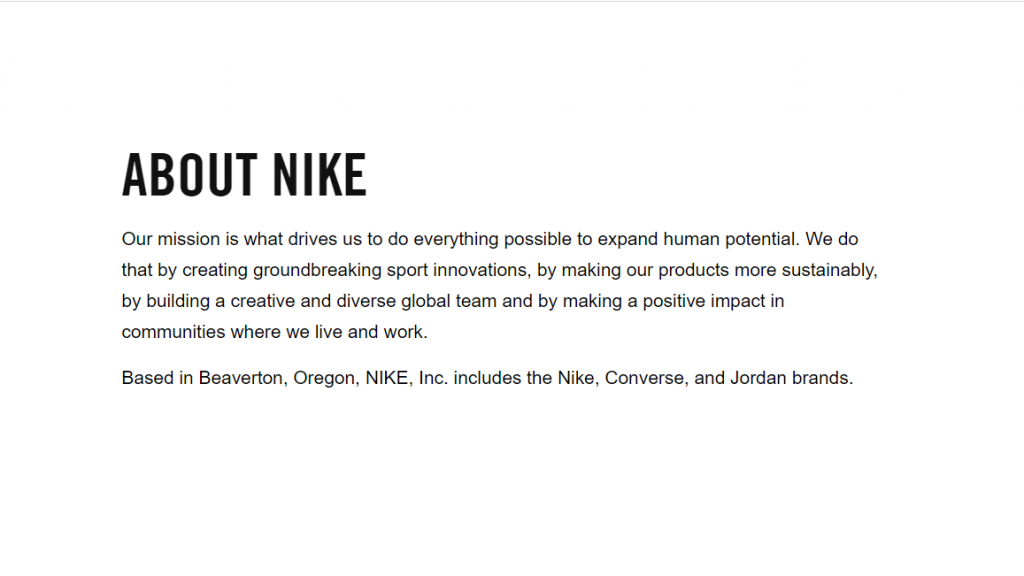
Seven years later, in 1971, the company had grown to fifty employees. The collaboration with the Japanese shoe supplier had ended and Phil chose a shoe factory in Mexico that had been endorsed by Adidas to manufacture his shoes.
He also needed a new name for his first order of leather soccer shoes which he would sell as football shoes. Looking for the best name, he ran a poll of his employees and came up with a name himself, Dimension Six which was rejected by everyone for being “unspeakably bad”.
The rest of the suggestions were not great also. Unfortunately, he didn’t have the time to come up with new names as he was on a deadline from the factory, the advertising department and the U.S. Patent Office where he needed to file paperwork with for his new shoe.
At the last minute, he received one more suggestion from Jeff Johnson, the company’s first employee. He said this particular name came to him in a dream the night before: Nike. It was the name of the Greek winged goddess of victory, it was short and had a strong sound thanks to the K letter. It had all the attributes of a good brand name that sticks in the mind of customers. With only a few seconds to make his decision, Phil chose Nike and the rest is history.
The company changed its name from Blue Ribbon Sport to Nike in 1978.
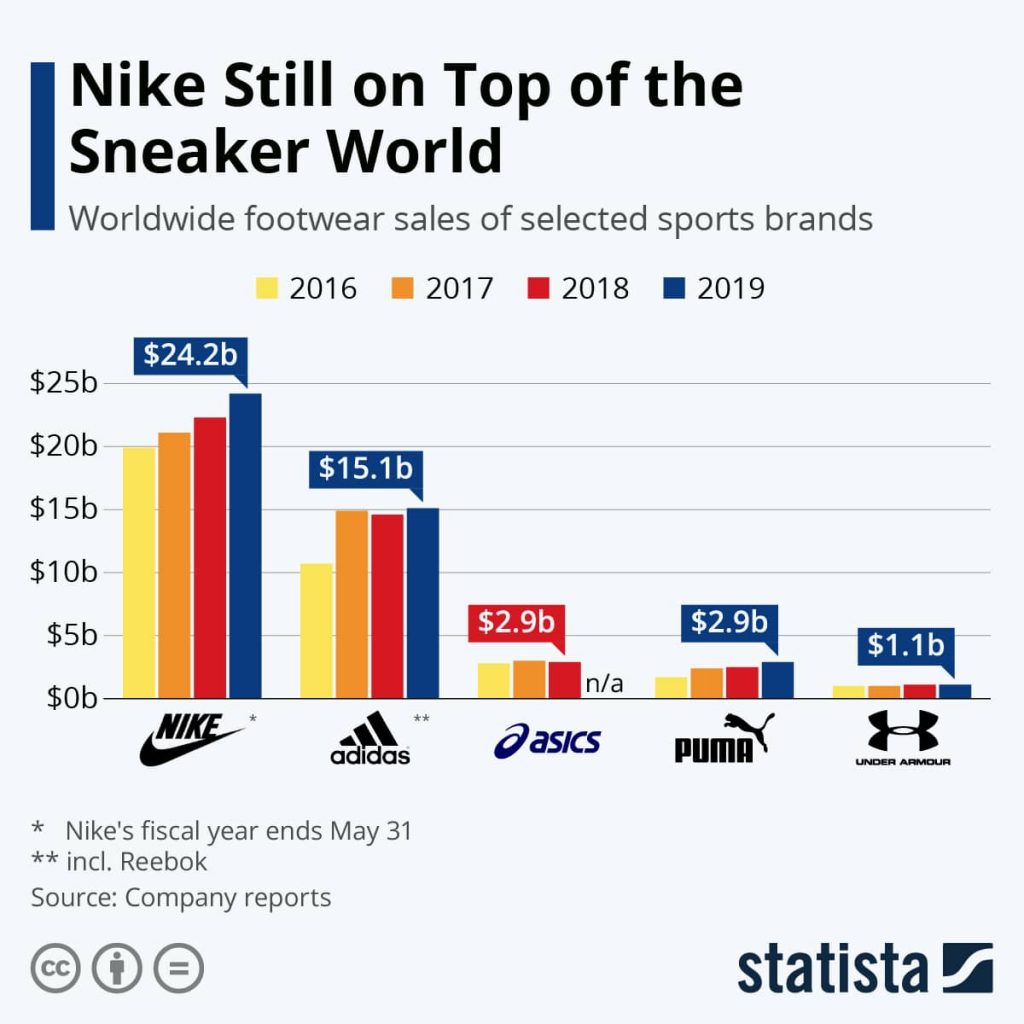
Source: Statista
The surprising story behind Just do it, NIKE’s iconic tagline
In 1987, Nike was preparing to launch its first major television campaign, which included commercials for running, walking, cross-training, basketball and women’s fitness.
Creative agency Wieden+Kennedy had been hired to create and run the campaign. Each spot was developed by a different creative team and Dan Wieden, founder of the agency felt the campaign needed a tagline that would bring everything together.
In a 2009 documentary about advertising, Dan confessed that he took inspiration from a convicted murderer’s last words to the firing squad before his execution: “Let’s do it!” Nike didn’t feel like the campaign needed the tagline but allowed it nonetheless.
Just do it is among the most popular taglines in the world. In just three words this simple tagline empowers athletes everywhere to stop overthinking and just take the first step. That’s all there is to it. Why? Because if you have a body, you are an athlete.

NIKE & Michael Jordan – the collaboration that gave NIKE a boost to global success and brand awareness
In 1983, Adidas was a billion-dollar company with a multinational operation leading the athletic footwear industry. Nike was already a strong competitor, gnawing at the company’s lead and looking for a way to overtake it.
In 1984, Michael Jordan was the undisputed star of basketball. He wanted to sign with Adidas, but Nike made him a better offer namely $ 500,000 a year for five years and the opportunity to design his line of shoes.
Listening to his parents’ advice, Michael Jordan said yes to Nike’s offer. The next year, Nike launched the first pair of Air Jordans onto the market.
The new shoe was insanely successful. The company sold $126 million worth of Air Jordans in the first year of the deal. A new edition of the shoe dropped every year of Jordan’s playing career.
Michael Jordan, considered by many to be the Greatest Of All Time in the history of the NBA made $1.3 billion from his thirty-six-year partnership with Nike.
His long-time collaboration with Nike helped the brand become the leading athletic shoe manufacturer in the world.
The company maintained its celebrity design collaborations as part of its business strategy. Over the years, the brand has collaborated with rapper and record producer Kanye West, singer and songwriter Drake, fashion house Dior, jewellery brand Swarovski, Louis Vuitton artistic director Virgil Abloh and founder and head designer of cult Japanese label Undercover Jun Takahashi.

How to grow your business with 1 strategy framework
NIKE has contributed to the rise of the sneakerhead culture
The sneakerhead culture began in the 1970s but Nike’s deal with Michael Jordan contributed to its global development.
Last year, Financial Times estimated the sneaker resale market was close to US$ 2 billion. The Jordan brand, a subsidiary of Nike, continues to largely drive sneaker sales, generating $US3.14 billion in revenue between May 2018 and May 2019. The Air Jordan 1 is widely credited as the shoe that began sneaker culture.
This year, the brand has also become one of the most valuable brands in the world. Michael Jordon’s game-worn autographed Nike Air Jordan 1S from 1985 sneakers sold for $560,000 at a Sotheby’s auction making them the most expensive sneakers ever sold.

Michael Jordon’s game-worn autographed Nike Air Jordan 1S from 1985 sneakers sold for $560,000 at a Sotheby’s auction (source: Sotheby’s)
The rarest and the most desirable sneaker ever made is the Nike MAG, the sneakers worn by Marty McFly when he time-travelled to 2015 in Back to the Future II 1989 movie. Although disintegrating, the sneakers sold for $92,100 in 2018. The money raised went to Michael Fox’s foundation for Parkinson’s research.
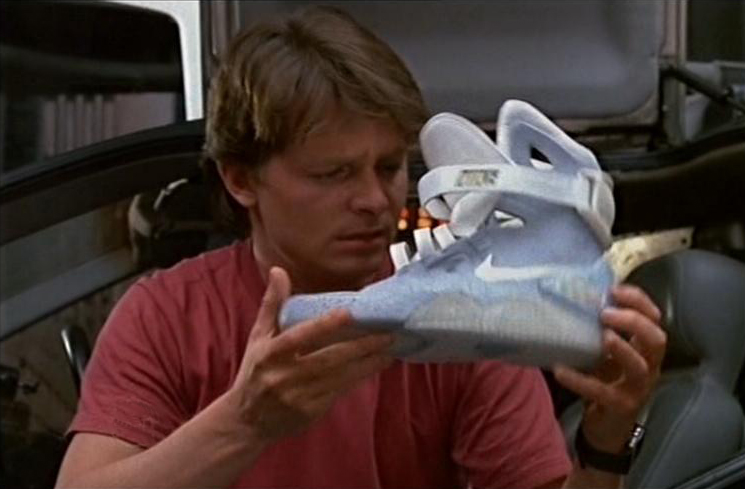
Actor Michael J. Fox and the NIKE Mag
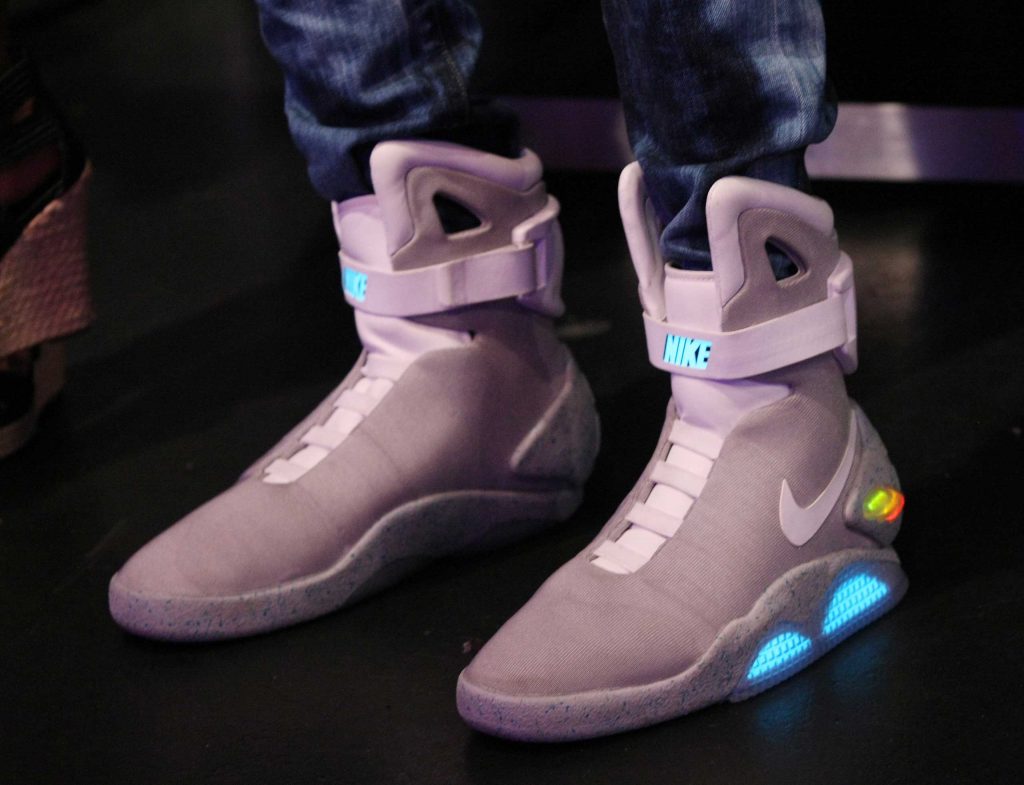
NEW YORK, NY – AUGUST 04:A general view of the audience members Nike “Back to the Future” sneakers 106 & Park at BET studio on August 4, 2014, in New York City. (Photo by Bennett Raglin/BET/Getty Images for BET)
Who is the biggest sneakerhead? The biggest sneakerhead is entrepreneur Miles Nadal, who spent more than US$1.2 million on a collection of rare sneakers in a sale managed by Sotheby’s in 2019. The collection included a pair of 1972 Nike Waffle Racing Flat “Moon Shoes”, one of the most significant artefacts in Nike’s long history.

The 1972 Nike Waffle Racing Flat “Moon Shoes”
NIKE today
Today Nike operates a total of 1,096 retail stores throughout the entire world.
The fifty-six-year-old company is the world’s largest athletic shoe manufacturer with an estimated market share of 28% and EURO 35 billion in revenue for 2019, followed by Adidas with EURO24 billion (Statista).
One of the brand’s core values is supporting and giving back to the community. To achieve this goal, Nike has created various funds:
Nike Community Impact Fund supports grassroots organizations in communities within the United States and Europe.
Nike School Innovation Fun partners with school leaders in Oregon to increase the number of students who graduate and to prepare students for college and careers.
Nike N7 creates positive change for the next generation of Native American and Aboriginal youth by getting kids active.
Through Nike Community Ambassadors more than 5,700 employees make a positive impact in communities around the world by providing quality coaching for kids in sports and play.
The brand isn’t afraid of creating controversy while standing up for its beliefs. After the 2018 Dream Crazy ad was launched, some people set their Nike sneakers on fire while others praised the brand for doing the right thing.
Combining innovation, great online and offline customer experiences, community engagement and fresh designs, Nike is one of the world’s forward-thinking brands that will stand the test of time.
Video streaming industry expected to grow to $150 billion by 2026
According to the latest research, the video streaming industry is expected to grow to $150 billion by 2026 at CAGR of 18%.
In this article:
- Video streaming industry stats and facts
- Key factors driving the video streaming industry growth
- Key restraining factors for the growth of video streaming industry
- Opportunities
Video streaming industry stats and facts
![]() Due to lockdown, Internet users are spending 32% of their time on streaming devices and platforms (Market);
Due to lockdown, Internet users are spending 32% of their time on streaming devices and platforms (Market);
 54% of Internet users are watching more shows and films on streaming services due to Covid-19 (Market);
54% of Internet users are watching more shows and films on streaming services due to Covid-19 (Market);
 Key players in the video streaming software market: IBM, Vimeo, Brightcove, Qumu, Kaltura, Wowza etc;
Key players in the video streaming software market: IBM, Vimeo, Brightcove, Qumu, Kaltura, Wowza etc;
 Key players in the VoD market: Netflix, Hulu, Disney, HBO, Apple, Google, AT&T, Amazon, YouTube;
Key players in the VoD market: Netflix, Hulu, Disney, HBO, Apple, Google, AT&T, Amazon, YouTube;
 Media and Entertainment, BFSI, Healthcare, and Academia and Education, eCommerce contribute to ~60-70% of the market;
Media and Entertainment, BFSI, Healthcare, and Academia and Education, eCommerce contribute to ~60-70% of the market;
 The fastest-growing video streaming market is China. China’s live-streaming industry has more than doubled in size compared with the previous year, reaching now $5 billion (Researchgate);
The fastest-growing video streaming market is China. China’s live-streaming industry has more than doubled in size compared with the previous year, reaching now $5 billion (Researchgate);
 In India, the video streaming industry is projected to reach $465 million by the end of 2020 (Statista)
In India, the video streaming industry is projected to reach $465 million by the end of 2020 (Statista)
 The largest video streaming market is the US. Here the video streaming industry is projected to reach $24 billion in 2020 (Statista)
The largest video streaming market is the US. Here the video streaming industry is projected to reach $24 billion in 2020 (Statista)
 The fastest-growing segments in the video streaming industry are:
The fastest-growing segments in the video streaming industry are:
- Video Analytics. Video analytics allow service providers to better understand their audiences, serve them better and thus, remain competitive.
- Live streaming. Live streaming helps audiences feel more engaged and more connected with the person in front of the camera.

Key factors driving the video streaming industry growth
 Increasing penetration of mobile devices and internet users
Increasing penetration of mobile devices and internet users
In 2020, the number of global smartphone users is projected to total 3.5 billion, marking a 9.3% increase from 2019. The current global population of 7.7 billion people means the smartphone penetration rate is at 45.4 %. (Oberlo)
Almost 4.66 billion people were active internet users as of October 2020, encompassing 59% of the global population. Mobile has now become the most important channel for internet access worldwide as mobile internet users account for 91% of total internet users. (Statista)
 Growing demand for VoD streaming
Growing demand for VoD streaming
According to Cisco, video will account for 82% of all Internet traffic by 2022.
 Remote work & Lockdown
Remote work & Lockdown
The COVID-19 pandemic has had serious consequences on business too with a large number of employees working remotely.
More than 1/4th of the world’s population went into lockdown. This has resulted in increased demand for online streaming and entertainment services.
Netflix added 26 million new subscribers in the first six months of 2020 which accounts for the company’s biggest growth spurt in history. As of the third quarter of 2020, Netflix had 195.15 million paid subscribers worldwide. (Forbes)
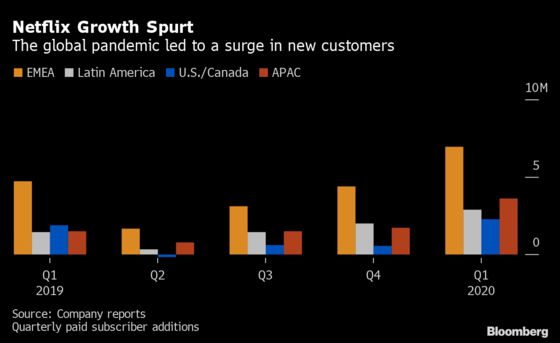
Disney+ launched a year ago with the goal of reaching 60 million to 90 million subscriptions by 2024. The company has recently announced that the platform surpassed 74 million subscribers by the end of 2020, outperforming all expectations. (CNBC)
Apple TV+ also launched a year ago and is included in the company’s One subscription bundle. The company hasn’t released any info regarding the number of its paying subscribers but estimations range from 10 million to 40 million subscribers. (TheVerge)
As of January 2020, there are over 150 million Amazon Prime Video users. (Market)
 Growing adoption of cloud-based solutions
Growing adoption of cloud-based solutions
The global public cloud service market is projected to reach $266 billion in 2020. This spells out a projected growth of 17.3% since 2018. According to Gartner’s forecast, infrastructure-as-a-service (IaaS) solutions, like cloud storage, will be the fastest-growing segment of the market with 24% predicted growth. (Hosting Tribunal)
 Growing demands of Live Video streaming solution
Growing demands of Live Video streaming solution
Over the past few years, going live on Facebook has become a popular feature among its users. Today live video is on almost every social platform: Instagram, Twitter, LinkedIn, Snapchat, YouTube etc.
 Technology innovations like blockchain and AI
Technology innovations like blockchain and AI
Video streaming as a service relies entirely on technology. Video streaming is not possible without video storage, encoding, networking and streaming. Blockchain technology expands storage options by spreading data across the blockchain computer network. Streaming video will be able to tap into underutilized computers through the Blockchain, which will dramatically reduce streaming’s cost (learn more).
From face recognition to chatbots and disease mapping, AI has a wide range of applications across many verticals. In video streaming, AI helps with workflow optimization, content-aware encoding and bandwidth use optimization while maintaining an appropriate level of quality. The main benefit of using AI in video streaming is cost saving.
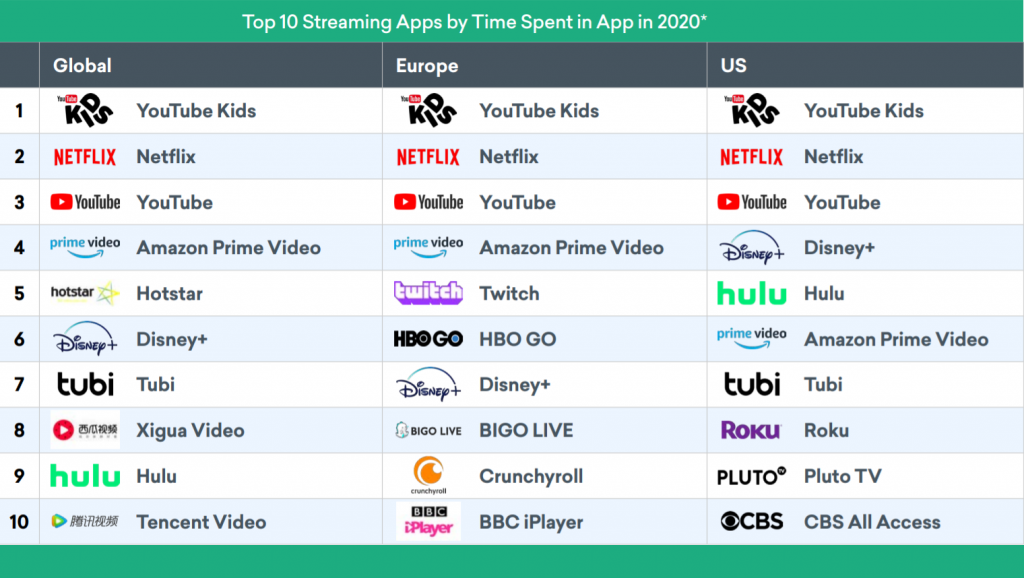
Key restraining factors for the growth of video streaming industry
- connectivity issues;
- latency and bandwidth issues which may result in poor quality video;
- a surge in internet traffic;
- data loss due to buffering;
- the disparity among software systems;
- high content cost;
- easy availability of pirated data;
- loss of personal and financial details.

Opportunities
Over the past few years, digital transformation has been in the top three goals for businesses everywhere.
The pandemic-induced lockdown forced businesses that had already started down this path to speed up and businesses that had a traditional high-street or in-person revenue generation model to pivot toward online and digital.
As a result, this year has seen teachers teach classes online to students ranging from first-graders to executive MBA participants.
Doctors see their patients through their PC’s camera first and popular talk show hosts broadcast from their homes.
Live music and business events have gone online, each of them looking to provide attendees with the best experience possible.
International banks with thousands of branches worldwide are making the most of the digital environment allowing their clients to keep safe.

Conclusion
Video streaming industry is projected to grow to $150 billion by 2026.
The industry has been growing steadily in recent years but the pandemic has accelerated its growth.
Remains to be seen if the industry will maintain its growth rate after the pandemic is over.
Join the Conversation
We’d love to hear what you have to say.
Get in touch with us on our LinkedIn Page, Facebook Page, Twitter or TikTok.
Porter’s Five Forces analysis of the IT industry
Porter’s Five Forces is a business framework that helps entrepreneurs shape their strategy to drive profitability. The framework is a holistic way of looking at any industry and understanding the structural underlining drivers of profitability and competition.
Learn more about Porter’s Five Forces.
Looking to increase your company’s profitability? Join our masterclass!
The IT industry in 2021
According to the research consultancy IDC, the technology industry is expected to reach $5 trillion in 2021 which represents 4.2% growth, signalling a return to the trend line that the industry was on prior to the pandemic.
The three major industry groups within the IT sector:
- software and services: companies that provide internet services, software and IT services, search engines or social networks, software for business or consumer use (Google, eBay, Facebook, Accenture, PayPal, Adobe, Microsoft and Electronic Arts (EA);
- technology hardware and equipment: companies that produce routers, telephones and switchboards, computers, printers and cell phones (Apple, HP, Dell, Motorola, Cisco Systems, SanDisk and Western Digital);
- semiconductors and semiconductor equipment: companies that produce semiconductor equipment (Intel, Microchip Technology, Nvidia, QUALCOMM and Texas Instruments).
4 IT industry trends according to CompTIA, a leading tech association
The Cloud-first mentality
With flexibility and resilience as the guiding principles for future success, organizations will adopt a cloud-first mentality when it comes to building or upgrading IT infrastructure.
Technology as a driver for business objectives
Businesses are placing much more emphasis on strategic IT as opposed to the tactical mindset of previous decades. This means that technology is a driver for business objectives rather than simply playing a supporting role.
Increased need for cybersecurity solutions
The complexity of new IT solutions creates a world of new opportunities. Unfortunately, it also creates a nasty problem for cybersecurity. (…) As companies become more comfortable with a zero-trust framework, they will also gain an appreciation for the new investments they have to make, the new processes they have to build, and the new skills they need to acquire.
Regulation is not avoidable
Whether it’s the debate over breaking up the largest tech companies, establishing clear legal ramifications and penalties for the exposure of sensitive user data, or figuring out how to thwart foreign countries from using social media to meddle in elections, the topic of regulation is front and center. […] the government is taking a closer look at all types of tech companies in an effort to rein in abuse and potential harm to the public – and assign accountability. [..] Regulation is not avoidable in the tech industry anymore.
Porter’s Five Forces Analysis of the IT industry
BUYERS – How much influence do buyers have on the IT industry?
Is there a large number of buyers relative to the number of IT companies? ![]() YES / NO
YES / NO
The IT industry is expected to reach $5 trillion in 2021 which represents 4.2% growth compared to last year. Digital transformation and technology have contributed to this growth.
Are buyers both B2C and B2B?  YES / NO
YES / NO
The IT industry caters to the needs of individuals and enterprises. According to this December 2020 report, the number of smartphone users in the world today is 3.5 billion, which translates to 44.69% of the world’s population. In 2019, there were over 2 billion computers in the world, including servers, desktops, and laptops. Although at home, we may prefer our smartphone, in the workplace, we do our work on PCs.
Do buyers face significant costs in switching suppliers?  YES / NO
YES / NO
Do buyers need a lot of important information with regards to using the products?  YES / NO
YES / NO
Does the product or service drive the buyer’s performance?  YES / NO
YES / NO
Are buyers able to manufacture the product/service in-house?  YES / NO
YES / NO
Are buyers highly sensitive to price?  YES / NO
YES / NO
Are products unique to some degree?  YES / NO
YES / NO
SUPPLIERS – How much influence do suppliers have on the IT industry?
Are inputs (material, labour, services) standard rather than differentiated?  YES / NO
YES / NO
Can companies switch suppliers quickly and easily?  YES / NO
YES / NO
Do suppliers find it difficult to enter the IT industry?  YES / NO
YES / NO
Is there a large number of current suppliers in the IT industry?  YES / NO
YES / NO
Is the IT industry important to the suppliers?  YES / NO
YES / NO
Is the supplier’s product indispensable to IT companies?  YES / NO
YES / NO
Microsoft has 13,000 U.S. suppliers. If you’ve made the list, it’s a great accomplishment. But keep in mind that every couple of years, Microsoft goes out to market and does a request for proposal or RFP. This means that depending on its current needs, Microsoft will look for fresh suppliers with innovative products or services.
Is an IT company important as a customer to the supplier?  YES / NO
YES / NO
Becoming a supplier for Microsoft means taking a slice of a $14.5 billion-worth budget pie that the software giant spends every year.
Microsoft is one of the leading IT companies in the world. Working with Microsoft is an accomplishment for any software supplier. But not every supplier can become a partner for Microsoft. The software giant has rigorous standards and high expectations for its partners. And once they’ve made to the list, it’s not over. Each supplier must undergo an annual review, receiving ratings of 1 to 5 for delivery, innovation, organizational health, quality, service supply-chain management and value.
NEW ENTRANTS – Is the threat posed by new entrants high or low?
Are economies of scale important?  YES / NO
YES / NO
Economies of scale is achieved when costs are lowered and production is increased. This happens because costs are spread over a larger number of goods.
Are economies of scope important?  YES/NO
YES/NO
Economies of scope is a concept which states that the unit cost to produce a product will decline as the variety of products increases. Namely diversity of products lowers the costs of producing them. Apple has the manufacturing capacity to design, manufacture and launch other products besides smartphones.
Would a new entrant be competing with established brands?  YES / NO
YES / NO
Any newcomer to, let’s say, the semiconductor industry would go against the market leaders Intel or AMD. They would need to spend significant amounts of money on advertising and promotions to attract customers.
Is a large amount of up-front capital required to enter the market?  YES / NO
YES / NO
New entrants in the semiconductor industry must develop strong research & development departments and large amounts of capital in order to compete with the patents of established companies.
Are profit margins in this market currently high?  YES / NO
YES / NO
A 2019 McKinsey report shows that profits in the semiconductor industry have been growing strong in recent years.
Are switching costs for customers high?  YES / NO
YES / NO
Embedded switching costs make it difficult and costly for customers to move from one brand to another.
Are there other barriers to entry: patents, regulatory requirements, experienced workers etc?  YES / NO
YES / NO
Is a new entrant expecting strong competition from the existing players?  YES / NO
YES / NO
SUBSTITUTES – Is the threat posed by substitutes high or low?
Are there available substitutes?  YES / NO
YES / NO
Do customers incur costs in switching to substitutes?  YES / NO
YES / NO
Do available substitutes have performance limitations?  YES / NO
YES / NO
Do available substitutes have high prices?  YES / NO
YES / NO
Are customers likely to go for substitutes?  YES / NO
YES / NO
Is it easy to replace one product with a substitute?  YES / NO
YES / NO
EXISTING COMPETITORS – What advantages do competitors have?
Are there many similar competitors in the IT market?  YES / NO
YES / NO
Are market shares equally distributed among competitors?  YES / NO
YES / NO
Are costs high?  YES / NO
YES / NO
Are the products being sold commodities, making it difficult to add value and have a high-margin?  YES / NO
YES / NO
Are exit barriers high?  YES / NO
YES / NO
Products on offer are highly complex and require significant customer-producer interaction.  YES / NO
YES / NO
Is the industry growing rapidly?  YES / NO
YES / NO
The IT industry is changing rapidly due to fast-evolving technology.
Conclusion
According to Porter’s Five Forces business framework, the IT industry landscape has the following features:
High competition
High bargaining power of buyers
Low threat of new entrants
Low bargaining power of suppliers
Low threat of substitutes
5 reasons for the failure of Thomas Cook, the world’s first travel agency
Table of Contents
Founded in 1845, Thomas Cook is the world’s first travel agency. A few years ago, the company was one of the world’s leading leisure travel providers operating in 17 countries, owning a fleet of aircraft and operating thousands of hotels around the world.
In 2019, the world watched its longest-running travel agency admit failure.
Let’s start from the beginning.
Thomas Cook – a short timeline
1845
Thomas Cook is an English businessman, who worked as a gardener and cabinet maker. He arranges for a party to travel from his hometown Leicester to Liverpool by train. Thus the world’s first travel agency is born. In 1846, he takes 350 people from Leicester on a tour of Scotland. A few years later he arranges for 150,000 people to travel to the Great Exhibition in London.
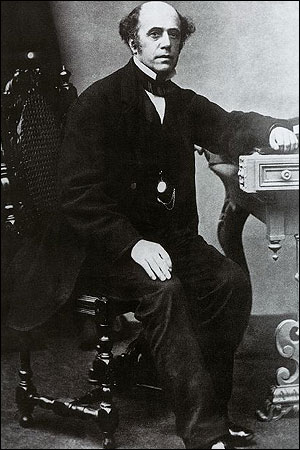
1855
In 1855, he plans his first continental tour, taking two groups on a grand tour of Belgium, Germany and France. The agency offers a complete package with its price including travel, accommodation and food, the first-ever of its kind.
1865-1866
The agency opens its first high-street shop in London. In 2019, the year of the collapse, the agency owns about 560 travel stores in the UK.
Thomas Cook’s son, John Mason personally conducts the company’s first American tour.
1872
Thomas Cook organizes the world’s first round-the-world tour. In the years to come, the company plans various tours to far-flung locations all over the world, including safaris in Africa. The company also expands into air and sea tours.
1965
The company’s net profits exceed £1 million for the first time.
1995
Launches thomascook.com, the first UK retail travel agency to offer customers a way to buy holidays online.
2000-2018
The company makes a series of acquisitions and mergers to extend its market share. The downside: acquiring a large debt.
2019
Royal Bank of Scotland, one of the company’s funders and a range of other banks demand that Thomas Cook Group PLC find $250 million in funding to ensure operations were protected.
The company’s management turned to the UK government for financial rescue. The UK government rejected its request.
Peter Fankhauser, Thomas Cook’s CEO, apologized to customers, employees, suppliers and partners and said the company “had no choice but to take steps to enter into compulsory liquidation with immediate effect” after talks on a financial rescue failed.” “This marks a deeply sad day for the company which pioneered package holidays and made travel possible for millions of people around the world.”
The group’s operations ceased immediately leaving around 600,000 tourists overseas including 150,000 British citizens.
It was the UK’s biggest peacetime repatriation.
Here’s another example: 4 reasons why fashion retailer Forever 21 went bust.
Thomas Cook – The scale of its collapse
Before entering into compulsory liquidation in 2019, here is an overview of Thomas Cook’s business:
- Thomas Cook Airlines owned a fleet of 93 aircrafts.
- The company employed approximately 21,000 staff worldwide, with 9,000 in the U.K.
- The agency offered its services in 17 countries either through its own branches or brand partners.
- Thomas Cook Group operated 3,170 hotels across 47 destinations.
- The group was the 2nd largest travel agency in Europe.
- Made EUR 9.5B in sales in 2018.
- Served 20 million customers every year.
- The company offered seven travel-related services: flights, hotel accommodation, cruises, foreign exchange, travel insurance, holiday packages, and one-stop shops, essentially meeting every need of its customers, from A to Z, with in-house resources.
Brand values: “Thomas Cook‘s promise to its customers is to be personal, trusted and innovative, placing them at the heart of everything it does.”
The downfall of Toys R Us – don’t blame Amazon!
5 reasons for Thomas Cook’s failure
- Late to change its business model;
- Failed to cut costs;
- Missed the opportunity to include Millennials among its customers;
- Didn’t come up with solutions to mitigate the consequences of Brexit;
- Acquired $2 billion in debt.
Late to change its business model
In 2017, Thomas Cook travel agents were still selling travel packages in high-street stores, while online sales in the UK were growing by as much as 30%.
The stores were in great locations and contributed to the company’s effort to maintain brand awareness. But the renting costs were high.
Thomas Cook began closing some of its physical stores and changed its strategy to an online platform. But it was too little too late and the online solution presented its own challenges apart from job losses which were significant. How to maintain online customer service at the same level as it was in physical stores when customers were talking to a person?
Failed to cut costs
In addition to cutting rental costs, the agency was struggling with the high costs of running an airline.
The airline industry is, in general, a highly competitive, low-profit margin industry. The customers are price sensitive and the internet environment allowed them to compare prices and go with the lowest. It is worth mentioning that most of Thomas Cook’s competitors did not operate flights directly.
Missed the opportunity to include the Millennials among its customers
With a new generation of travellers entering the market, the industry was bound to change. Millennials are different from their parents and their grandparents in terms of how they like to travel.
A 2016 survey revealed that Millennials would rather take more short trips – at least seven – throughout the year rather than one vacation package. That’s why city breaks became in high demand among this generation and the travel services providers had to adapt to this new way of travelling.
Also, Millennials behaved differently in that they planned their own itineraries, used digital tools (like Airbnb or Booking.com), focused on transformational experiences and were influenced by social media or user-generated content (source).
Thomas Cook failed to adapt to this new type of customer and as a result, its sales were going down.
Didn’t come up with solutions to mitigate the consequences of Brexit
The UK was set to leave the EU and that caused high levels of uncertainty and anxiety among the British people.
With neither the government nor the media shedding light on the issues at hand, the agency’s customers in the UK decided to postpone their holidays.
Brexit affected Thomas Cook negatively, especially since the agency didn’t come up with a solution to this situation.
Acquired large debt over the years
Over the years, following many acquisitions and mergers, the company acquired a $2 billion debt which it wasn’t able to solve.
The problems related to the company’s debt began to be relevant around 2010. The company’s growth was not possible without external financing.
Conclusion
In the span of 174 years, pioneer Thomas Cook had become one of the leading companies in the travel industry.
I believe two aspects of its collapse could have been prevented.
What happened was, as usually is the case with legacy brands, the company failed to adapt to technology and customer behaviour change.
In business, early adopters of the latest technologies turn the threat into an opportunity. Thomas Cook was a late adopter. Their customers shifted to online services before they did which resulted in the company losing the advantage and momentum. This is ironic, since Thomas Cook, the company’s founder started the agency by leveraging a new piece of technology which had just been introduced in the US, in the early 1800s: rail transportation. Read another example of a global brand that went bankrupt.
They also failed to keep a close eye on their customer’s buying behaviour and profile. A new generation was looking to travel, a new type of customer very much different from their customer base had entered the travel market and they were blind to the change. Customer behaviour analysis should be conducted periodically, not when sales are down. Understanding the psychological profile of our customers is essential.
Top 5 most in-demand soft skills you need to grow in 2021
Looking to develop your soft skills? Read on to discover the Top 5 most in-demand soft skills you need to grow in 2021.
Professional growth and career advancement hinge on the employee’s desire and ability to learn new things.
Whether you are looking to specialize in your field which means you’d want to go deep, or you are looking to diversify which implies going left and right (learn more about the T-shaped marketer), learning never stops. And it shouldn’t, rightfully so.
Over the past few years, LinkedIn, the 722-million member professional social platform, has been curating a list of the most in-demand soft and hard skills employers are looking for.
Here is LinkedIn’s list for the most in-demand soft and hard skills 2020.
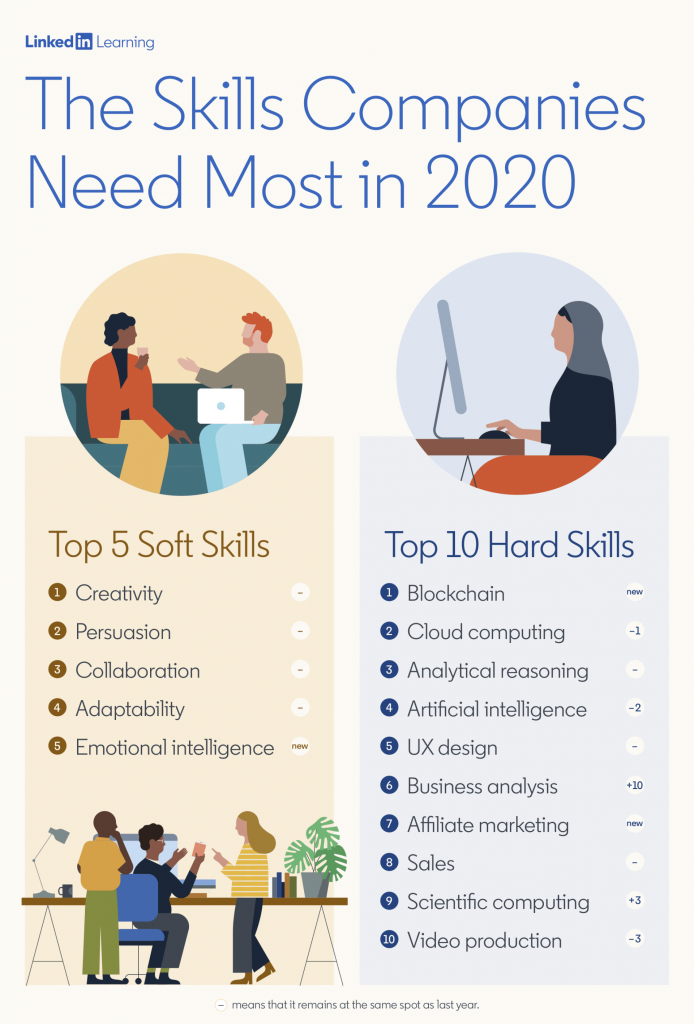
What are the Top 5 soft skills companies look for in their employees and new hires in 2020?
- Creativity
- Persuasion
- Collaboration
- Adaptability
- Emotional intelligence
Let’s talk about each of them.
1. CREATIVITY
Creativity is now the #1 soft skill companies are looking for three years in a row.
Why is creativity in such high-demand?
Listen to creativity expert and BRAND MINDS speaker Denise Jacobs:
Can creativity be taught or is it an inherent trait?
I believe one of the most creative organizations in the world today is NASA. Going into space requires finding solutions to unique problems and even unknown situations. That certainly pushes the brightest minds at NASA to come up with creative and out-of-the-box solutions.
In the 1960s, NASA reached out to Dr George Land, a creative performance researcher and enrolled his expertise in devising a creativity test to help with the selection for innovative engineers and scientists. Dr Land accepted the challenge and devised a creativity assessment that worked very well.
Inspired by the results and curious to know more about where creativity comes from, Dr Land conducted a research study to test the creativity of 1,600 children ranging in ages from 3 to 5 years old. He re-tested the same children at 10 years of age, and again at 15 years of age. And then he extended the testing pool to include 1 million adults.
What exactly did Dr Land test for?
He tested for the ability to look at a problem and come up with new, different and innovative ideas.
Here are the results:
5-year-olds: 98% imaginative
10-year-olds: 30% imaginative
15-year-olds: 12% imaginative
31-year-olds: 2% imaginative
That’s quite a shock, isn’t it?
We are the most creative in our childhood and we lose our creativity growing up.
What is the reason?
Dr Land gave the following explanation in his book, Breaking point and beyond:
What we have concluded is that non-creative behaviour is learned.
Is there something we can do about it?
In his 2016 Tedx Talk, Dr Land says there is a way to undo this process.
Let’s hear from Dr Land (08:37):
First of all, we need to think about creativity beyond artistic abilities.
Artists are not the only creative people.
Professionals in every industry have the ability to be creative. Because in the workplace, being creative means looking at a problem from a different viewpoint and coming up with a fresh solution, as Dr Land explained a few years ago.
It’s not about waiting to be inspired; it’s about thinking creatively.
According to Martin Lindstrom, brand expert and BRAND MINDS speaker, the first step towards creativity is taking time off from your smartphone, observing the people around you and essentially allowing yourself to be present.
2. PERSUASION
In business communication, persuasion is the process of presenting arguments to move, motivate, or change your audience.
Persuasion is one of the most important skills that a leader needs. He has the vision and he sets the goal; he needs to move and motivate his employees to fulfil the vision and meet the goal.
It’s the leader who tells his colleagues Come with me and let’s accomplish the mission together. This is the authoritative leader who provides employees with inspiration, motivation, empowerment and a sense of accomplishment.
Or the visionary leader whose motto is Embrace my vision. This type of leadership is called visionary leadership. The visionary leader must hone his persuasion skills to inspire and motivate people to pursue a long-term vision. Learn more about leadership styles: 12 Leadership Styles for Successful Leaders (complete list) with Pros & Cons.
Persuasion skills are necessary for sales and marketing as well. With a 30-year career researching the science of influence, Dr Robert Cialdini is the world’s most renowned persuasion expert and a BRAND MINDS speaker.
His Theory of Influence is based on seven key principles:
- Reciprocity,
- Commitment and consistency,
- Social proof,
- Authority,
- Liking,
- Scarcity,
- Unity.
Brands build on them to increase brand awareness and sales. Dr Cialdini’s latest insights on persuasion are in his 2016 book Pre-Suasion: A Revolutionary Way to Influence and Persuade.
3. COLLABORATION
We are living and working in a fast-paced environment.
Startups with a handful of employees that work as one are able to move quickly and more efficiently. Corporations with thousands of employees are slow and bureaucratic.
There are many examples of hundred-year-old brands outcompeted by new entrants on the market.
That’s where agility comes into play as a way of organizational transformation with one goal: adapt.
Want to learn more about agility? Read 22 benefits of the agile organization.
For an organization to become agile, its employees must form small teams. Every team member is expected to collaborate with each other. And that’s more difficult than you might think.
To meet the set goals, team members must learn to listen to each other, be supportive, be generous, learn to communicate clearly and openly, share knowledge and information, refrain from judgement, reject bias, debate and adapt.
The team leader must also be an example of effective communication and collaboration.
4. ADAPTABILITY
At the time of writing, the world has been fighting to end the COVID-19 pandemic for almost a year.
Our private and professional lives have been profoundly affected.
Many businesses are fighting to survive while others have already closed their doors. Adaptability has never been more important.
Why are companies looking for employees with a high ability to adapt?
Because these employees are a great asset to the company.
Highly-adaptable employees are:
- Willing to experiment;
- Undeterred by failure;
- Use the failure as an opportunity to learn;
- Resourceful;
- Keep an open mind;
- Have a growth mindset.
5. EMOTIONAL INTELLIGENCE
Emotional intelligence is a new entry in LinkedIn’s Top 5 most in-demand skills of 2020.
Why are companies looking for emotional intelligent employees?
Let’s first find out what is emotional intelligence.
Emotional intelligence is the ability to perceive, evaluate, and respond to your own emotions and the emotions of others. It’s the skill that facilitates and nurtures the other four.
Daniel Goleman, one of the world’s leading psychologists and BRAND MINDS speaker, introduced the concept of EQ or emotional intelligence in his 1995 bestseller, Emotional Intelligence.
According to Daniel Goleman, there are 5 key elements of emotional intelligence:
- Self-awareness;
- Self-regulation;
- Motivation;
- Empathy;
- Social skills.
Employees with high EQ collaborate better, are more adaptable, use persuasion for the right reasons, are motivated and able to motivate others.
The workplace benefits from increased engagement and the business are more likely to find creative ways to stay ahead of the competition.
Join the Conversation
We’d love to hear what you have to say.
Get in touch with us on our LinkedIn Page, Facebook Page, Twitter or TikTok.
BUSINESS reSOURCES: Grow your business with Porter’s 5 Forces framework
On this page:
- What is Porter’s 5 Forces business framework?
- How to evaluate Porter’s 5 Forces (explained)
- 11 Benefits of applying Porter’s 5 Forces framework to grow your business
- 6 recommendations for a successful business strategy
What is Porter’s 5 Forces business framework?
Porter’s 5 forces is a holistic way of looking at any industry and understanding the structural underlining drivers of profitability and competition.
Porter’s 5 Forces framework is a valuable business tool that helps entrepreneurs shape their strategy to drive profitability.

Business strategist Michael E. Porter
The framework was created by Michael E. Porter, an economist, researcher, author and Harvard Business School professor. His expertise focuses on market competition and company strategy. His extensive research is widely recognized in governments, corporations, NGOs, and academic circles around the globe.
Strategy can be viewed as building defences against the competitive forces or as finding positions in the industry where the forces are weakest.
Michael E. Porter
How to evaluate Porter’s 5 Forces (explained)
1. Existing rivals
Evaluate the existing rivals by looking at the number of competitors. Are there many competitors? How do they rate in terms of size and power? Are they clearly differentiated or are their products almost identical?
What is the size of the competitors?
What is the industry growth rate: slow or fast?
Is product differentiation between competitors present?
What about exit barriers: are they high or low?
2. Buyers
The buyers are powerful and can influence the industry if they make purchases in large volumes.
Is the product undifferentiated? If that’s the case, the buyer will be price-sensitive and the digital environment allows the buyer to instantly compare prices and choose the cheapest.
Is there a large customer base? Do they have many alternatives to buy from? When the buyers are interested in high quality, they are not price-sensitive.
3. Suppliers
How much control does a supplier have over your business?
Does it influence your business by raising the cost of their products and lowering quality?
How many suppliers are in the industry? The fewer they are, the more powerful they are to control the industry and influence your profit margin.
Factors in determining supplier power: number of suppliers and concentration, switching costs, availability of substitutes, uniqueness of product, whether or not the industry is an important customer of the supplier and its availability to cut out the middle man.
4. Substitutes
Substitutes are alternative products that fulfil the same need by different means. In the airline industry, the substitutes are trains and cars.
Rule of thumb: don’t limit your analysis to your industry. Expand your approach to products that meet the same need but are in different industries.
How many alternatives to your product are on the market?
How can you rate the buyers’ willingness to switch and choose a substitute instead of your product?
What is the price-performance ratio of the substitutes?
5. New rivals
Is the entry barrier low or high?
If the entry barrier is low, which means requirements to enter the industry are affordable or readily accessible, then there are increasing chances of new entrants in great numbers. In this case, the threat is high.
There are six major sources of barriers to entry: economies of scale, product differentiation, capital requirements, cost disadvantages independent of size, access to distribution channels and government policy.
In a future envisioned by Elon Musk, people will fly from New York to Shanghai in a rocket, not an airplane and it will take only 10 minutes instead of 24 hours. The downside of this type of futuristic fast-travel may prove to have a high price.
A different way of fast and affordable transportation shines brightly in the near future: the hyperloop. Read about the hyperloop.
11 Benefits of applying Porter’s 5 Forces Business Framework
If you have a great idea, the next step is not product development, logo design, or assembling the best team.
If you’re contemplating starting a business, the first thing you should do is industry analysis and look at the competitor environment before anything else.
And that’s why Porter’s 5 Forces framework is of paramount importance to any entrepreneur: it helps to design a successful business strategy that will support the business to achieve its goals.
11 benefits of applying Porter’s 5 Forces Business Framework
- Evaluate the roots of long-term profitability in your industry.
- Discover the trends that are most likely to be significant in changing the game in the industry.
- Where are the constraints which if you can relax, it might allow you to find a really strong competitive position?
- Avoid getting trapped or tricked by the latest trend or technological sensation.
- Focus on the underlying fundamentals.
- Analyze your competition and how it is affecting the profit.
- Learn how to approach competition in your industry.
- Identify the structure of the industry.
- Find answers to the question How is the industry changing?
- Get the tools to understand industry dynamics.
- Position your business to find that spot in the industry where you can have a really good profit.
6 Recommendations for a successful business strategy
The goal of Porter’s business framework is not to find the weaknesses of your competitors in order to drive them out of the market.
As Michael Porter says, it’s not a zero-sum game. By applying this framework, you get valuable insights which in turn can help you identify a specific and unique way in which to delight your customers.
Your business can delight your customers in one way, the competitors can delight their customers in another way.
It’s a better strategy rather than engaging in price wars which is not a long-term strategy.
When creating your strategy based on insights gained by applying Porter’s 5 Forces framework, take into account the following recommendations:
- Choose a supplier group to buy from that exercises less power over your business;
- Perform buyer selection i.e. choose a buyer group to sell to that leverages a low power over your business;
- Your business can sell to powerful buyers if it partners with a low-cost supplier or the product is unique;
- When creating your strategy, factor in the substitutes that are subject to trends improving their price-performance tradeoff with the industry’s product;
- Devise a solution to not merely survive the forces, but change them;
- Keep a close eye on industry evolution.
The key to growth—even survival—is to stake out a position that is less vulnerable to attack from head-to-head opponents, whether established or new, and less vulnerable to erosion from the direction of buyers, suppliers, and substitute goods. Establishing such a position can take many forms—solidifying relationships with favourable customers, differentiating the product either substantively or psychologically through marketing, integrating forward or backwards, establishing technological leadership.
Michael E Porter
Conclusion
Porter’s 5 Forces Framework is a very robust framework, easily applicable to all industries, allowing entrepreneurs to position the business so as to be least vulnerable to the industry’s competitive forces.
Join the Conversation
We’d love to hear what you have to say.
Get in touch with us on our LinkedIn Page, Facebook Page, Twitter or TikTok.
Source: How Competitive Forces Shape Strategy by Michael E. Porter
4 brilliant marketing skills to achieve success in 2021
Looking to achieve success in 2021 as a marketer? Check these 4 brilliant marketing skills!
1. Automation skills
Automation is the elimination of all manual labour through the use of automatic controls that ensure accuracy and quality and was first coined in the 1940s at the Ford Motor Company. Automation ushered in the industrial revolution by producing goods at scale faster and better than the traditional man-powered system.
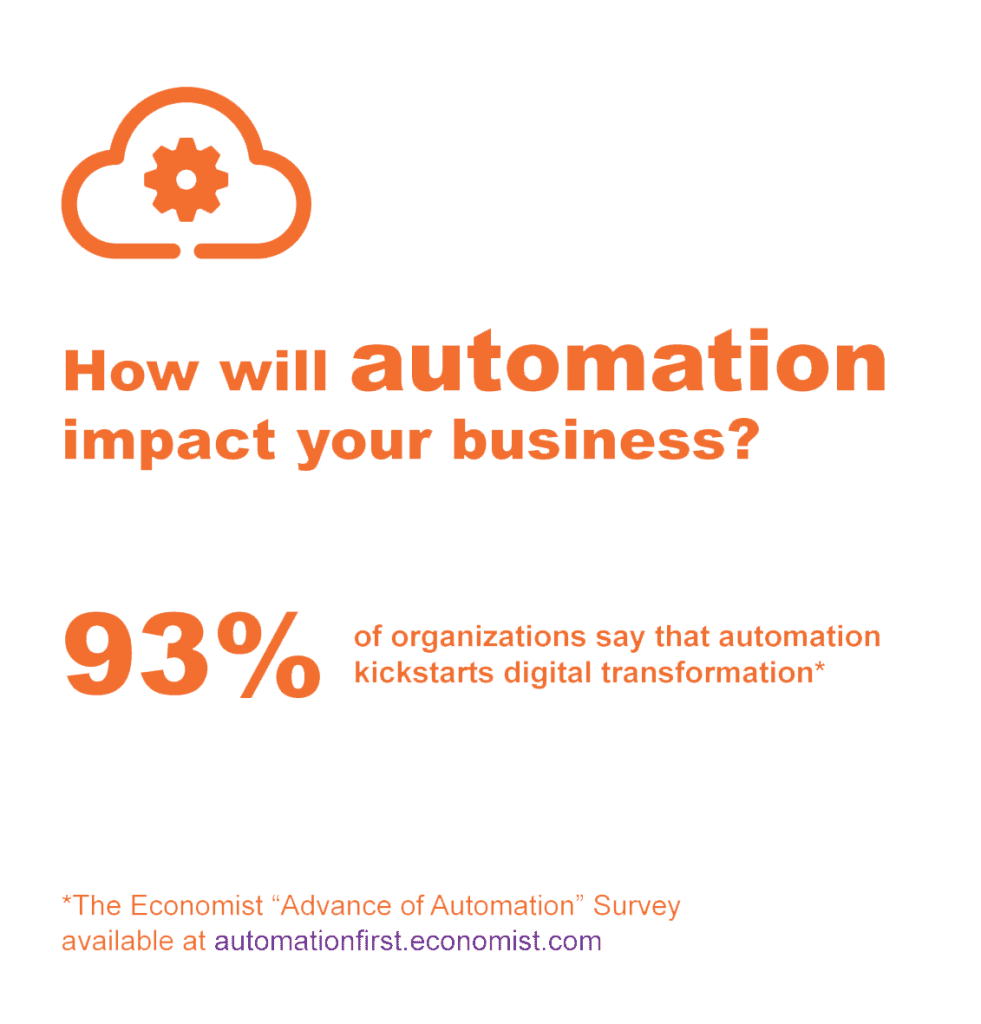
Business-wise, automation supports the organization’s efforts of streamlining its operations and processes thus freeing the employees from doing time-consuming tasks and allowing them to tackle creative tasks where they can add real value.
Learn more about business automation in 4 technologies every business should use to achieve its goals effectively in 2021.
In October 2020, leading Robotic Process Automation software (or RPA) UiPath’s survey on automation skills found that 70% of senior executives want non-technical employees to have automation and AI skills.
They also believe that employees with automation and AI skills will benefit from increased career advancement opportunities.
We are living in a digital world so it stands to reason that marketers should make the most of any digital tools that could help them achieve their goals.
What marketers are looking for is the next big idea that will increase market share, brand awareness and generate sales. Time is of the essence in any business, but in marketing, this is abundantly true. So automating time-consuming tasks whenever possible helps marketers become more efficiently and accurately.
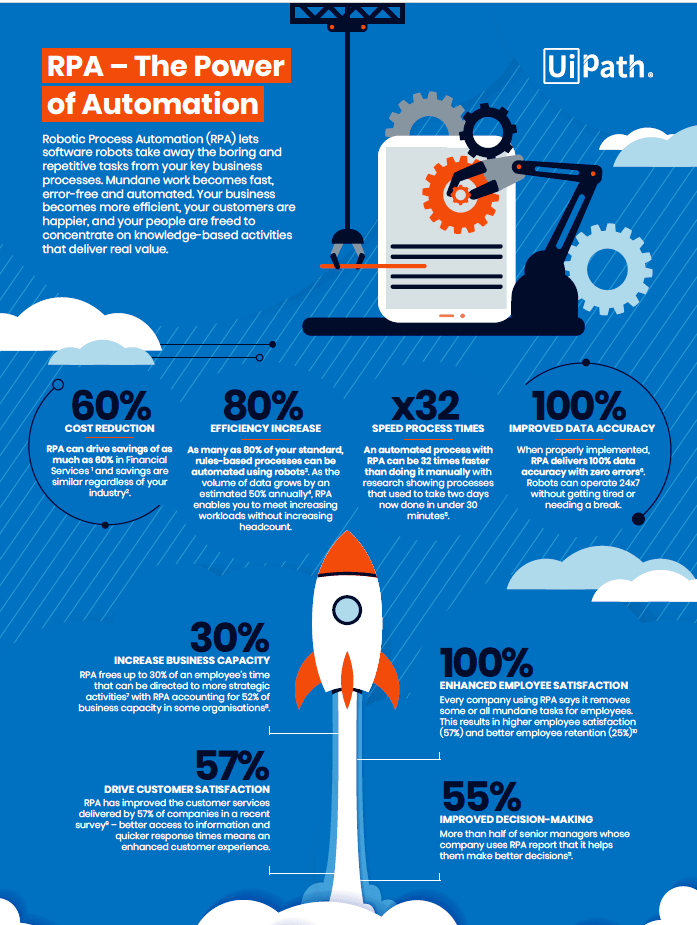
Infographic source: uipath.com
Here are some of the tasks you can assign to a software robot aka automate:
- Data integration with Excel automation for financial analysis;
- Data manipulation;
- Screen scraping;
- Create automation for single activities, desktop applications, multiple actions, web apps, and virtualized environments;
- PDF data extraction;
- Email automation.
Do you need any programming skills to automate tasks?
No.
RPA doesn’t require any programming skills to get started.
That’s great news but how come, you might ask?
The RPA software records tasks as they are being worked on by you and then replay these recorded tasks and voila!
Your mini-digital-you is doing them faster and better so you can focus on more important tasks.
To learn more about automation or begin upskilling, check out UiPath Academy’s free RPA training.
2. Trendwatching skills
BRAND MINDS 2020 speaker Gary Vaynerchuk started the Wine Library TV four months after YouTube launched in 2005. He was the first entrepreneur to build video content for a brick-and-mortar business.
Fifteen years later, Gary is now a digital expert and media icon with a combined 16-million followership. Having foreseen the video content trend taking off definitely helped him.
Watching the trends is a skill every marketer should start developing today. Not every brand can be a trendsetter, but every brand should watch the trends taking off or slowing down.
When marketers pair this kind of insight with creativity and a marketing goal, it’s a boost to the brand’s competitive advantage. And that could potentially be what separates one brand from its competition.
Here are 3 trend watching tools that you should explore:

Trendwatching is one of the world’s leading consumer trend firms since 2002. It is purpose-built to guide, inspire and empower business professionals. The company relies on its proprietary Purpose-Driven Innovation (PDI) methodology, a core analytical framework that turns trends into meaningful business opportunities.

Glimpse identifies growing trends by analyzing hundreds of millions of consumer behaviour signals from across the web, including products, companies and industries. Did you know that Chessable, a platform teaching players about different chess openings, endgames, and tactics has seen an increase in online popularity? It’s partly due to Netflix’s release of The Queen’s Gambit, which prompted the searches and online discussion of chess to double.

Trend Hunter boasts a monthly viewership of 20 million and identifies as a trend community. The company leverages big data, human researchers and AI to identify consumer insights and deep dive opportunities for the world’s most innovative companies. Among standard trends categories such as products, brands, topics or people, Trend Hunter also includes ideas as part of its offer.
3. Growth marketing skills
What is growth marketing?
Let’s look at three definitions of growth marketing I curated from different sources. Observe the bolded words.
The first definition says growth marketing is defined as the strategies, tactics and techniques used to focus on growing a business, product or service. Unlike regular marketing activities, the emphasis and activities focus on accelerating growth. (source)
The second definition says growth marketing is a process of rapid experimentation across marketing channels and product development to identify the most efficient ways to grow a business. (source)
The third definition of growth marketing goes as follows: Growth marketing is an approach to attracting, engaging, and retaining customers that’s focused on relentless experimentation and an intense focus on the unique, changing motives and preferences of your customers (source).
As you can see, there is no single accepted definition of growth marketing but some parts do overlap. The bolded words in each definition are my way of helping you see where that definition directs its focus.
So what’s growth marketing?
The first says it’s about strategies, techniques and tactics, which is an outward overview. The second talks about a process of rapid experimentation (speed) and includes product development which is an interesting approach. The third looks inward and makes the customers its focal point. It also includes experimentation, but this time it’s not about speed, but endurance over a long period. Think Sir Mo Farah, the marathon runner instead of Usain Bolt, the fastest man in the world.
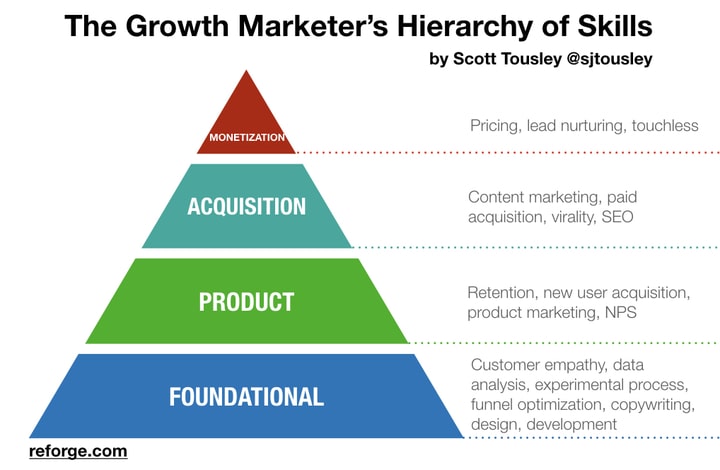
Seeing that growth marketing has so many definitions, what is the role of a growth marketer?
Also, don’t confuse growth marketer with growth hacker. According to Sean Ellis, the original growth hacker, a growth hacker is “the unique hybrid between a coder and a marketer”, thinking of growth first, budget second. He takes advantage of systems based on loops and goes deeper into the customer funnel.
Today’s fast-moving digital business environment requires marketers to turn into T-shaped marketers.
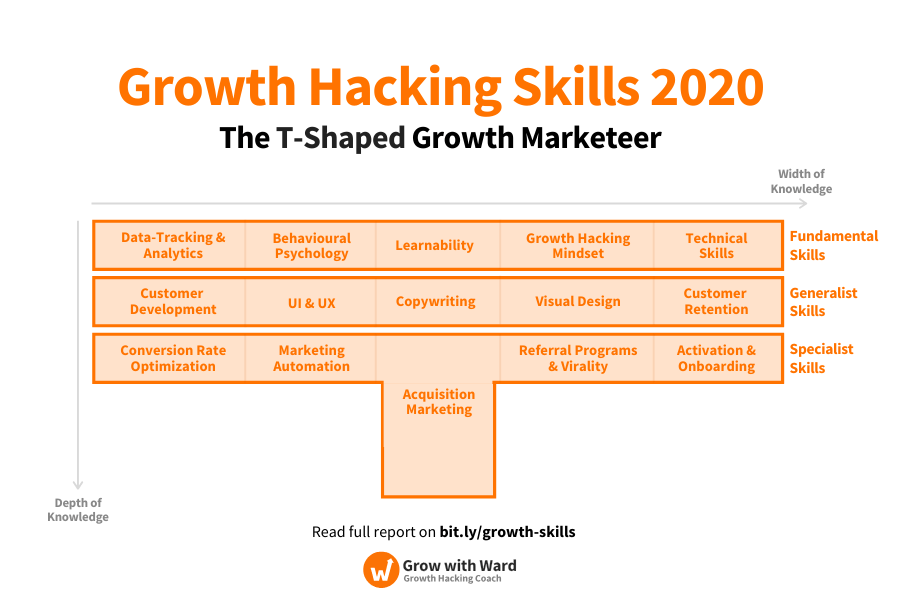
Fundamental growth marketing skills:
- Data-tracking & analytics
- Behaviour psychology
- Learnability (the desire and ability to grow quickly and adjust one’s skillset)
- Growth-hacking mindset
- Technical skills
Generalist skills:
- Customer development
- UX & UI development
- Copywriting
- Visual design
- Customer retention
Specialist skills:
- Conversion rate optimization
- Marketing automation
- Acquisition marketing
- Referral programs & virality
- Activation & onboarding
4. Stay informed
Successful marketers know what’s going on in the industry.
They follow the trends and the numbers, but, more importantly, they follow the people.
And I’m not talking about big celebrities, although every marketer should be aware of their power to influence communities and consequently their customers (there’s always a lesson to learn here).
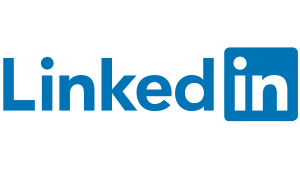
What I’m talking about is connecting with industry experts in various verticals on LinkedIn or other social media platforms.
From experienced sales professionals to UX designers, video content creators to business analysts, consumer behaviour specialists to performance marketers – they are valuable resources for any marketer looking to succeed today.
Follow them and you will always stay updated with the latest trends in marketing in particular and business in general.
Also, you will know what other brands do well or not so well. Why Quibi, the USD 2 billion-startup founded by one of the most powerful producers in Hollywood, led by an experienced CEO and slated for success, crashed and burned in just six months after its launch? There are definitely two lessons to be learned here: one is related to leadership, the second is related to marketing.
Use LinkedIn to achieve your professional goals. Connect with or follow industry experts or peers that share valuable insights. If you don’t know where to begin, check out LinkedIn’s Top Voices 2020 list.
Join the Conversation
We’d love to hear what you have to say.
Get in touch with us on our LinkedIn Page, Facebook Page, Twitter or TikTok.
4 technologies every business should use to achieve their goals effectively in 2021
What are 4 technologies every business should use to achieve their goals more effectively in 2021?
1. Digital Automation
What is automation? Automation is the elimination of all manual labour through the use of automatic controls that ensure accuracy and quality.
The term automation was first coined in the 1940s at the Ford Motor Company and was applied to the automatic handling of parts in metalworking processes.
The industrial revolution leveraged the power of machines to produce goods at scale. The digital revolution began in the late 1970s and ushered in a new way to manage business processes.
The benefits of automating business processes are many, ranging from efficiency boost, reduced costs to increased productivity.
Automation in business means using technology to replace manual effort and repetitive tasks allowing employees to tackle creative tasks or other projects where they can add real value.
In October 2020, leading Robotic Process Automation software (or RPA) UiPath’s survey on automation skills found that 70% of senior executives want non-technical employees to have automation and AI skills.
Here are 6 examples of business automation tools:
- ServiceNow is a cloud-based workflow automation platform that enables enterprise organizations to improve operational efficiencies by streamlining and automating routine work tasks;
- ActiveCampaign is a marketing automation platform, combining advanced email marketing features and an enterprise standard CRM;
- Hootsuite automates your social media marketing;
- Grammarly automates proofreading and spell-checking;
- Agile CRM automates workflows across sales channels;
- Zoho Recruit helps HR managers source, track, and hire the best candidates;
The global marketing automation market size alone was valued at USD 4.06 billion in 2019 and is expected to grow with 9.8% from 2020 to 2027 (source).
Is your business automating its processes? How much of your employees’ tasks are automated to reduce time, cut costs and increase productivity? Is your organization going through digital transformation?
2. Robotics
In 1947, science fiction author Isaac Asimov devised the Three Laws of Robotics, a set of rules created to protect humans interacting with robots.
The robots that we see now are yet to achieve the sophistication level of the robots that Asimov has imagined seventy-three years ago.
Our robots come in many shapes and sizes. From standard robotic arms working in factories to Amazon’s cobots packing orders five times faster than a human warehouse worker and Sophia, the humanoid AI Robot who can simulate a full range of facial expressions, look people in the eyes and conduct natural conversations with them.
The robotics industry market is predicted to exceed USD24 billion by 2030, an increase with a CAGR of 28.6%. Find other interesting robotics industry statistics and the latest challenges in robotics.

Mos Burger’s remote-controlled robot (source: japantoday.com)
The latest innovation in robotics comes from Mos Burger, a Japan-based burger chain which tested the OriHime robots in its restaurants. These robots are remote-controlled by restaurant employees from home. Each robot is clad in a trainee uniform and equipped with a microphone and camera, so workers can personally serve customers and answer their questions about the menu (source).
In this example, the robots are not taking the jobs of the restaurants’ employees but act as a replacement, a body double if you will. An innovative solution perfectly adapted to pandemic times.
Farming is another industry with great potential for automation. Spot, the now-famous Boston Dynamics dog-like robot opens doors, walks up and down the stairs, carries payloads of up to 14kg and can haul a truck together with nine of his “siblings”.
Recently this year, a fleet of Spots was deployed to a farm in New Zealand to conduct agricultural tasks: inspecting crops, navigating rough terrain and gathering data in real-time. It was strange seeing the robot successfully herding sheep. Yes, the robot-like dog could prove more useful to any farmer, but it won’t replace a dog’s playful bark and loving eyes any time soon.
3. The surprising use of gaming in business
It’s been almost a year since the pandemic started. At first, we were happy to use Zoom and Zoom was certainly happy to see its stock more than double (up 107.2%) over the past three months and skyrocket nearly eightfold (up 680.2%) year to date (source).
Now we’ve grown increasingly tired of going on Zoom meetings. Mental health experts identified two new work-related conditions: Zoom fatigue and Zoom burnout.
Is there a more pleasant way of conducting team meetings or business meetings?
Gaming seems to be the answer for some professionals. Why stare at your colleagues inside six or nine small screens when you can bond on Red Dead Redemption 2? Why add to your business partner’s zoom fatigue when you can relax first, go shoot some guns in Grand Theft Auto and then discuss business details as this New York Times article points out.

Unilever Russia went even further and designed a career fair in the format of an online game, where users could visit 8-bit versions of company office buildings, learn job details and communicate with virtual representatives.
4. Augmented Reality experiences for a touchless economy
2016 will go down in history as the year the world saw a cultural phenomenon go global, the PokemonGo.
It is estimated that 27 million users played the AR-based game and $950 million in revenues were generated.
The same year, Snapchat bought Augmented-Reality start-up Cimagine Media.
Today Snapchat is synonymous with AR. Recently, the company rebranded itself as a camera company, with the goal of empowering people to express themselves, live in the moment, learn about the world, and have fun together.
AR is Snapchat’s unique feature that attracts over 170 million Snapchatters, nearly 30 times every day according to the latest reports by Snap.

Snap Local Lense (image source: wired.com)
This year, the social media company launched Local Lens, a new feature that promised to transform whole neighbourhoods into digital canvases.
Apart from the obvious entertainment opportunity, AR is also a tool that can be used by businesses to drive engagement and fulfil customers’ needs.

image source: Trendwatching.com
Augmented reality firm Moviebill launched Inflight, AR versions of airlines’ safety cards, duty-free magazines, and inflight menus.
How does Inflight work? Passengers can use their smartphones to scan an image (such as an airline’s logo) on their tray table to see the content ‘come to life’ in 3D. The idea is to help airlines get rid of items that are touched by many crew members and passengers, as well as create more engaging customer experiences.
Do you think your business could implement this technology for the benefit of its customers?
3 Creative Augmented Reality (AR) Award Winning Marketing Campaigns
Curious to learn how brands use AR (augmented reality) technology to design creative award-winning marketing campaigns?
Here are 3 creative augmented reality (AR) award-winning marketing campaigns for your inspiration
JFK MOONSHOT Campaign – Winner in Augmented Reality, at the 12th annual Shorty Awards
The JFK Moonshot campaign was launched in 2019 by the JFK Presidential Library & Museum to celebrate 50 years from the Apollo 11 Mission. The mission was the first spaceflight that landed humans on the Moon and one of the greatest technological achievements of the 20th century.
Seven years earlier, John Fitzgerald Kennedy gave his now-famous “We choose to go to the moon” speech in which he characterized space as a new frontier and outlined the pioneering spirit of the American nation.
We choose to go to the Moon in this decade and do the other things, not because they are easy, but because they are hard; because that goal will serve to organize and measure the best of our energies and skills, because that challenge is one that we are willing to accept, one we are unwilling to postpone, and one we intend to win, and the others, too.
John F Kennedy, “We choose to go to the Moon”
In 1969, almost 600 million people around the world tuned in to watch man’s first steps on the moon with excitement and awe. In 2019, thanks to its augmented reality-based campaign, the JFK Presidential Library & Museum prompted the same emotions of bewilderment and curiosity.
JFK Moonshot was a fully-synchronized augmented reality recreation of Apollo 11 where every moment, manoeuvre, and milestone unfolded in real-time, second-by-second.
Campaign challenge:
Celebrate 50 years from the launch of Apollo 11
JFK Moonshot Campaign features:
- Dedicated mobile app;
- Interactive AR games;
- Archival NASA footage;
- Educational multimedia experiences;
- a 363-foot, full-scale replica of the Saturn V rocket, one of the largest AR objects ever created;
- Livestreaming of the AR launch and entire mission on Twitch, the popular gaming platform.
Campaign viewers were invited to:
- Explore and launch an AR replica of the Saturn V rocket;
- Track 100+ hours of the Apollo 11 mission in real time with archival NASA footage;
- Play AR games designed to extend their knowledge of the mission with JFK-related trivia questions;
- Learn about JFK’s critical role in the moon landing through educational multimedia experiences;
- Record and share the mission’s most epic moments with friends and family;
- Practice their own moon landings with interactive AR games.
Campaign results:
- 110,000+ rocket launches around the world;
- 140,000+ downloads of the app;
- 8x more social mentions than competitive museums;
- 240,000,000+ global brand impressions;
- An 11% increase related to JFK inspiring innovation.
ADIDAS ORIGINALS DEERUPT Campaign – Winner in Augmented Reality, at the 11th annual Shorty Awards
Adidas’ campaign, Originals Deerupt was created with a specific community in mind: the sneakerheads.
What is a sneakerhead? A sneakerhead is someone who collects, trades and or admires sneakers as a hobby. Sneakerheads see sneakers as status symbols and they are mostly Millennials and Generation Z-ers.
The sneakerhead culture began in the 1970s and the internet turned it into a global phenomenon. These days sneakers are like stocks and last year, Financial Times estimated the sneaker resale market close to US$2billion.
Some say the rarest and the most desirable sneaker ever made is the Nike MAG, the sneakers worn by Marty McFly when he time-travelled to 2015 in the Back to the Future II movie.
The biggest sneakerhead? The biggest sneakerhead is entrepreneur Miles Nadal, who spent more than US$1.2 million on a collection of rare sneakers in a sale managed by Sotheby’s last year. The collection includes a pair of 1972 Nike Waffle Racing Flat “Moon Shoes”, one of the most significant artefacts in Nike’s long history.
Campaign challenge:
Launch Deerupt in such a way to combat low-quality photos that emerge on the internet as a result of product leaks and democratize unboxing.
Adidas Originals Deerupt launch campaign features:
- The AR rendering of the DEERUPT;
- A dedicated mobile web platform that allowed Sneakerheads to use their smartphone cameras to see and interact with an AR rendering of the DEERUPT;
- Empty shoe boxes sent to high profile sneakerheads;
- In-store experiences around the world.
Campaign results:
- 110 Million views;
- 50,000+ virtual unboxings;
- 123+ countries.
#ROMANOVS100 AR PHOTO ALBUM Campaign – Winner in Creative use of technology, the 12th annual Shorty Awards
#Romanovs100 is an educational project designed to bring to light a part of Russian history which has been erased from the history books by the Soviet rule. The Romanovs were Russia’s last Royal family, executed by the Bolsheviks 100 years ago.
The inspiration for this campaign came from the Romanovs themselves. They were pioneers of photography capturing almost every meaningful event in their lives with Kodak cameras, the world’s first portable cameras.
Fortunately, the Romanov archive has been preserved. The team unearthed over 4000 photographs which were adapted to digital formats allowing the campaign to make history easily accessible and engaging as well.
Campaign challenge:
Transform content to an interactive AR book which makes learning experiences an emotional journey into history.
Campaign features:
- 180° retro images in spherical view, 3D immersive experience;
- 42 short documentary-style videos;
- A limited print edition of the project using AR technology to create an interactive history book;
- Ambrotype posters – Photo teasers using 160-year-old ambrotype photography technique;
- Original soundtrack;
- Music video combining photos & VR Animation;
- The world’s first-ever digital colourization contest.
Campaign Results:
- 25 million impressions;
- 55,000 fans and followers;
- +1 million post engagements;
- +1 million video views;
- 500,000 minutes watched;
- #Romanovs100 on Twitter grew 2000%
- Global media coverage: BBC Newshour, History Extra etc
Join the Conversation
We’d love to hear what you have to say.
Get in touch with us on our LinkedIn Page, Facebook Page, Twitter or TikTok.


